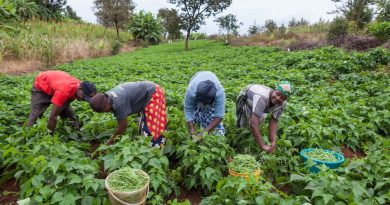Livestock insurance Keeping Livestock Farmers Afloat in Rwanda after Rift Valley Fever
Rwandese Livestock farmers have resorted to taking insurance to cushion them against losses as a result of the death of animals due to the rift valley fever (RVF) disease attacks.
Many farmers in the country, especially in Eastern Province, have suffered heavy losses of their livestock due to deadly attacks by the RVF. Rwanda, a country with extensive cattle production, reported RVF outbreak in Eastern Province in 2018. .
RVF is a mosquito-borne viral disease that can be transmitted from animals to humans. It causes severe disease in animals that is characterized by fever, weakness, abortions (loss of pregnancy), and a high rate of severe illness and death, particularly among the young animals.
Isaac Mahoro, 37, a livestock farmer from Nyamata sector in Bugesera district, says that his diary cow died from RVF but because he had insured them against such risks, the insurance company compensated him for the loss.

Bugesera District office
Mahoro had just bought the cow that turned out to be infected from a livestock farmer in neighboring Ntarama sector also in Bugesera district, Eastern Province.
He says that it was there for a very short time before it got sick. “At first we thought it was theileriosis so we started to give related medicine. The cow had high fever and later became too weak to move. We injected it with calcium and other medicine, thinking it was suffering from theileriosis.
“My cows were all vaccinated; I think it’s the reason why they were able to resist RVF despite having it,” he says, adding: “If we knew immediately that the cows, including the new one, had RVF and not Theileriosis as we had wrongly assumed, we would have used the recommended RVF case management regimen,” Mahoro reflects.
Theileriosis is a disease caused by Theileria – a blood-born parasite; it only affects cattle and is primarily transmitted by ticks.
It was the autopsy carried out on the dead cow that revealed it had RVF. Later, the tests conducted for his other cows revealed that the two of them had RVF but were asymptomatic.
Mahoro is a business-oriented livestock farmer with 20 dairy cows that produce at least 300 liters of milk per day. He affirms that the cows are the lifeline for him and his family. “That’s why I insured every one of them and I have spent over two million Rwandan francs to insure around 50 cows that passed in my farm since I started livestock farming,” he intimates.
The process of compensation starts by a livestock farmer filling a form that specifies what the cow died of together with an autopsy report.
The form is signed by the veterinary doctor who treated the cow, and the veterinary doctor licensed by the insurance company.
The form goes to the insurance company after being signed by the area sector administration. The process takes not less than two months to be compensated.
For the cow that died from RVF, the insurance paid Mr. Mahoro 1,200,000 Rwandan francs (Rwf). The insurance is 5.5 percent of the value of one cow and it’s paid once per year.
Laurent Karemera, 64, a business-oriented livestock farmer from Ntarama sector, Bugesera district, also has a similar experience.
Karemera does insemination for his cattle to produce an improved breed which he also sells to other livestock farmers.
“With symptoms similar to other diseases, RVF surprised us. At first, many cows aborted at the same time, but again some of them were asymptomatic. My two Friesians aborted in that period while another started to show similar symptoms. I tried all sort of medication that we normally use for theilerioses and Anaplasmosis (an infectious vector-borne disease caused by a tick spreading bacteria and characterized by fever, decrease milk yield, progressive anemia and constipation among others), which are common. The fever sometimes was high and down but never left, finally the cow died,” said Karemera.
“We treated cows with all available medicine, such as Bitalex until it ran out of stock. When by chance you got it, it was very expensive, with one bottle cost around Rwf 50,000. We opted to use generic medicine which are not original and cows finally died.”
Karemera says that it was the first time in his whole career to see cows getting sick and die at that extent. In a farm of 14 cows, two aborted, two died while four recovered after treatment. He had to sell the other four that were not pregnant to avoid losing them also.
“First two cows aborted, while I was still recovering, two others died and four others were already sick. When they came to vaccinate them, they said pregnant cows could not be vaccinated because the vaccine itself could make the cow to abort. Besides, the vaccine reached my area late,” he said.
The work of livestock insurance
Karemera says that between the two cows that died, one of them was compensated by livestock insurance while the other was not. This was because when it died Karemera was not around and they did not perform autopsy, which is the key element in the insurance compensation file.
The initial value of his cow was about Rwf 1,500,000, he paid around Rwf 82,500 (5.5 percent) with the 40 percent of the government support, and the insurance compensated him with Rwf 1,200,000.
How does the livestock insurance work?
The government of Rwanda initiated the livestock insurance program for livestock farmers where they pay 60 percent of the insurance cost and the government pays the rest 40 percent in social support. However, not all animals were selected for this kind of insurance. The priority was given only to dairy cows and productive pork and chicken.
Dr. Fabrice Ndayisenga, the Director of animal resources development unit, Rwanda Agriculture and Animal Resource Development Board (RAB), affirms that this program is not found anywhere else in this world except Rwanda, which offers such brilliant support to farmers.
Even so, the program is greatly challenged by low uptake because some say the cost of the insurance is too high and is beyond their means.
To some farmers the problem was lack of awareness. For example, James Nyaburinga, a livestock farmer from Nyagatare district whose livestock died from RVF complications, says that the thing he regretted the most is that he did not insure his cows beforehand because the idea never crossed his mind and the insurance campaign were not that frequent at that time.




